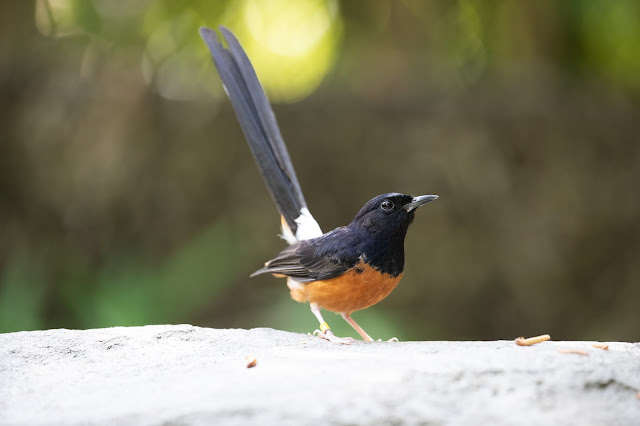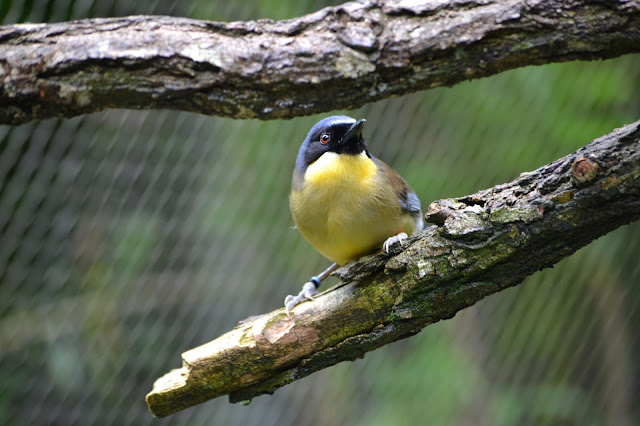Posted by Kayla Hanada, Animal Keeper
Hello! My name is Kayla and I am an animal keeper at Woodland Park Zoo working primarily in our bird areas. The next time you’re checking out our adorable Asian small-clawed otters in the Banyan Wilds habitat area, turn around. There's a wonderful aviary right behind you full of beautiful birds—and I’d love to tell you about them!
 |
| The white-rumped shama thrush in the Banyan Wilds aviary has a beautiful song! Photo: Jeremy Dwyer-Lindgren/Woodland Park Zoo |
 |
| The Chinese hwamei looks like its wearing white "cat eye" makeup. Photo: Jeremy Dwyer-Lindgren/Woodland Park Zoo |
This aviary is currently home to six different species native to Asia and the Indian subcontinent, with 19 individual birds in total! It’s one of my favorite groups of birds. The white-rumped shama have beautiful songs, the Chinese hwameis have wonderful white "cat eye" makeup, the azure-winged magpies are always “talking” and moving around, and the Nicobar pigeons have incredible iridescent feathers and bright yellow toenails. But it’s the final two species that I’d like to focus on today: the Malayan great argus—which is a kind of pheasant—and the blue-crowned laughingthrush.
 |
| The Nicobar pigeon has beautiful iridescent plumage. Photo: Dennis Dow/Woodland Park Zoo |
We have both a male and a female great argus. Our male has beautiful, long feathers that might look like those on a peacock’s tail (arguses and peacocks are both from the same family of birds) but they’re different. The long feathers that the male uses for display are actually wing feathers. The name of the species comes from Argus, the giant from Greek mythology who had 100 eyes. Argus pheasants have an intricate pattern on their feathers with hundreds of dots—a reference to those eyes. The female, which is smaller in size, also has a beautiful pattern of tiny spots.
 |
| A male Malayan great argus does an amazing display with his wings to impress his potential mate. Photo: Dennis Dow/Woodland Park Zoo |
The male argus has a really interesting mating dance. The process begins with him clearing out a spot (an arena) on the ground for his courtship display and making a very loud call. Then he will start stomping and flipping his wings up to show off that beautiful feather pattern. This year was the first time I finally saw him do this display in person and it is incredible! He must have impressed our female argus too, because the result was that they hatched a chick this year. The youngster—which is a male—can be seen following its parents around, and sometimes gets so close to its mom that it almost disappears under her, making it look like she has four legs. It will also hide under her when its resting, with only its little beak poking out from under her feathers.
 |
| The newest addition to the aviary, an argus chick, almost disappears under his mother, making it look like she has four legs! Photo: Jeremy Dwyer-Lindgren/Woodland Park Zoo |
Now to the blue-crowned laughingthrush—a very special species. We have four of them in the Banyan Wilds aviary that arrived here in Seattle only a few weeks ago. They are named Rose, Blanche, Dorothy, and Sophia—names chosen by our team of animal keepers. It’s no surprise that our "golden girls" have quickly stolen my heart.
 |
| Blue-crowned laughingthrush, Rose, gets a worm! Photo: Jeremy Dwyer-Lindgren/Woodland Park Zoo |
Each of them has their own unique combination of colored bands on their legs, which helps us tell them apart, but they also have some behaviors that help with that too. Rose is a bit more “standoffish” than the other three, not really wanting to take worms (a favorite treat) from us and preferring to pick them up herself. Blanche came to us with a beautiful tail and feather quality in comparison to the other three. Dorothy is the largest of the four and one of our pushiest. She has decided that the giant mealworms are her favorite and if I don’t have any of them with me, she gives me a “look” and leaves. Sophia is also not shy about coming over, taking her worms and hanging out a little bit before leaving.
I feel very lucky to work with these girls, as they are listed as critically endangered—one step away from being extinct in the wild! There are only about 300 blue-crowned laughingthrushes left in their native habitat in small fragmented areas of southern China. There are also about 300 of them that live in human care in conservation-based zoos around the world including in Hong Kong, Denmark, the UK, Prague and here in Seattle. We are working together, through the World Association of Zoos and Aquariums (WAZA) to try to sustainably grow the population and save this species from extinction—and one of our colleagues here at Woodland Park Zoo helps run this international conservation effort.
In addition to our “golden girls” in the Banyan Wilds aviary, there is a separate pair of blue-crowned laughingthrushes that live in their own quiet "love nest" behind the scenes. Even though you can't see this pair, we are hoping the extra privacy will encourage them to mate and raise chicks. They've already shown some really positive breeding behaviors this year, so keep your fingers crossed for them! We’ll be sure to keep you updated as having blue-crowned laughingthrush chicks would be a huge boost for this critically endangered species.
 |
| Dorothy is the largest of our blue-crowned laughingthrushes. Photo: Kayla Hanada/Woodland Park Zoo |
Thank you for letting me tell you a little bit about our beautiful little aviary and some of our marvelous birds. Keep an eye out for more chicks as the season goes on, and have a great day!



Comments
Post a Comment